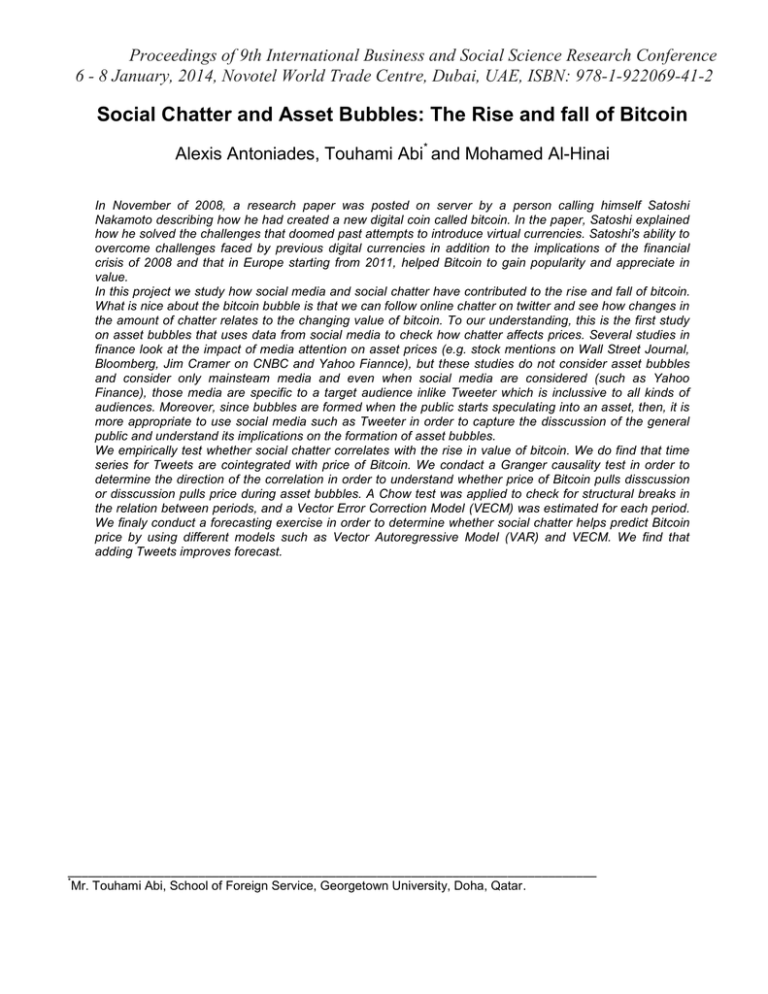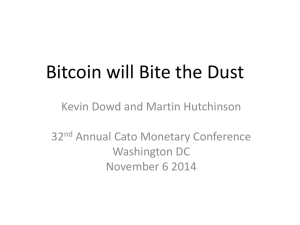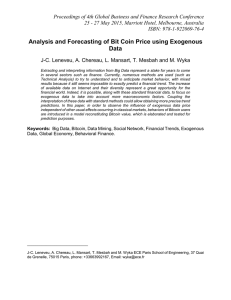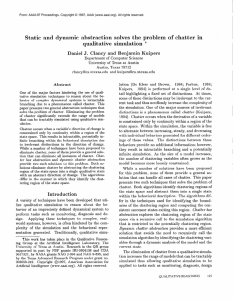Proceedings of 9th International Business and Social Science Research Conference
advertisement

Proceedings of 9th International Business and Social Science Research Conference 6 - 8 January, 2014, Novotel World Trade Centre, Dubai, UAE, ISBN: 978-1-922069-41-2 Social Chatter and Asset Bubbles: The Rise and fall of Bitcoin Alexis Antoniades, Touhami Abi* and Mohamed Al-Hinai In November of 2008, a research paper was posted on server by a person calling himself Satoshi Nakamoto describing how he had created a new digital coin called bitcoin. In the paper, Satoshi explained how he solved the challenges that doomed past attempts to introduce virtual currencies. Satoshi's ability to overcome challenges faced by previous digital currencies in addition to the implications of the financial crisis of 2008 and that in Europe starting from 2011, helped Bitcoin to gain popularity and appreciate in value. In this project we study how social media and social chatter have contributed to the rise and fall of bitcoin. What is nice about the bitcoin bubble is that we can follow online chatter on twitter and see how changes in the amount of chatter relates to the changing value of bitcoin. To our understanding, this is the first study on asset bubbles that uses data from social media to check how chatter affects prices. Several studies in finance look at the impact of media attention on asset prices (e.g. stock mentions on Wall Street Journal, Bloomberg, Jim Cramer on CNBC and Yahoo Fiannce), but these studies do not consider asset bubbles and consider only mainsteam media and even when social media are considered (such as Yahoo Finance), those media are specific to a target audience inlike Tweeter which is inclussive to all kinds of audiences. Moreover, since bubbles are formed when the public starts speculating into an asset, then, it is more appropriate to use social media such as Tweeter in order to capture the disscussion of the general public and understand its implications on the formation of asset bubbles. We empirically test whether social chatter correlates with the rise in value of bitcoin. We do find that time series for Tweets are cointegrated with price of Bitcoin. We condact a Granger causality test in order to determine the direction of the correlation in order to understand whether price of Bitcoin pulls disscussion or disscussion pulls price during asset bubbles. A Chow test was applied to check for structural breaks in the relation between periods, and a Vector Error Correction Model (VECM) was estimated for each period. We finaly conduct a forecasting exercise in order to determine whether social chatter helps predict Bitcoin price by using different models such as Vector Autoregressive Model (VAR) and VECM. We find that adding Tweets improves forecast. _____________________________________________________________________________ * Mr. Touhami Abi, School of Foreign Service, Georgetown University, Doha, Qatar.



